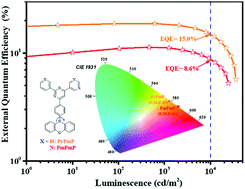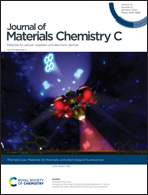Applying intermolecular hydrogen bonding to exploit TADF emitters for high-performance orange-red non-doped OLEDs†
Abstract
Exploiting novel TADF emitters for highly efficient orange-red non-doped organic light-emitting devices (OLEDs) is a research hotspot. Nevertheless, serious non-radiative transitions of the electrogenerated excitons significantly hinder the pace of the development. Herein, two novel donor–π–acceptor (D–π–A) type TADF emitters 10-(4-(2,6-di(pyridin-3-yl)pyrimidin-4-yl)phenyl)-10H-phenoxazine (PyPmP) and 10-(4-(2-(pyridin-3-yl)-[4,5′-bipyrimidin]-6-yl)phenyl)-10H-phenoxazine (PmPmP) were designed and synthesized. In their crystals, suitable intermolecular hydrogen bonding interactions are observed that enable head-against-tail 3D supramolecular frameworks. Such frameworks not only prefer a high horizontal molecular orientation but also strictly restrict the non-radiative process in non-doped conditions. Their non-doped OLEDs realize decent orange-red electroluminescence with maximum current efficiencies (CE), power efficiencies (PE), and external quantum efficiencies (EQE) of 50.5 cd A−1, 53.5 lm W−1, and 18.8% for PyPmP, 23.2 cd A−1, 22.1 lm W−1, and 11.3% for PmPmP, respectively. Moreover, both devices can still retain high efficiencies as luminance increases, and exhibit a neglectable efficiency roll-off at 1000 cd m−2. These results are among the best of ever reported orange-red non-doped OLEDs. These results demonstrate that intermolecular hydrogen bonding interactions can play important roles in exploiting TADF emitters for high-performance orange-red non-doped OLEDs.

- This article is part of the themed collection: Materials for thermally activated delayed fluorescence and/or triplet fusion upconversion


 Please wait while we load your content...
Please wait while we load your content...